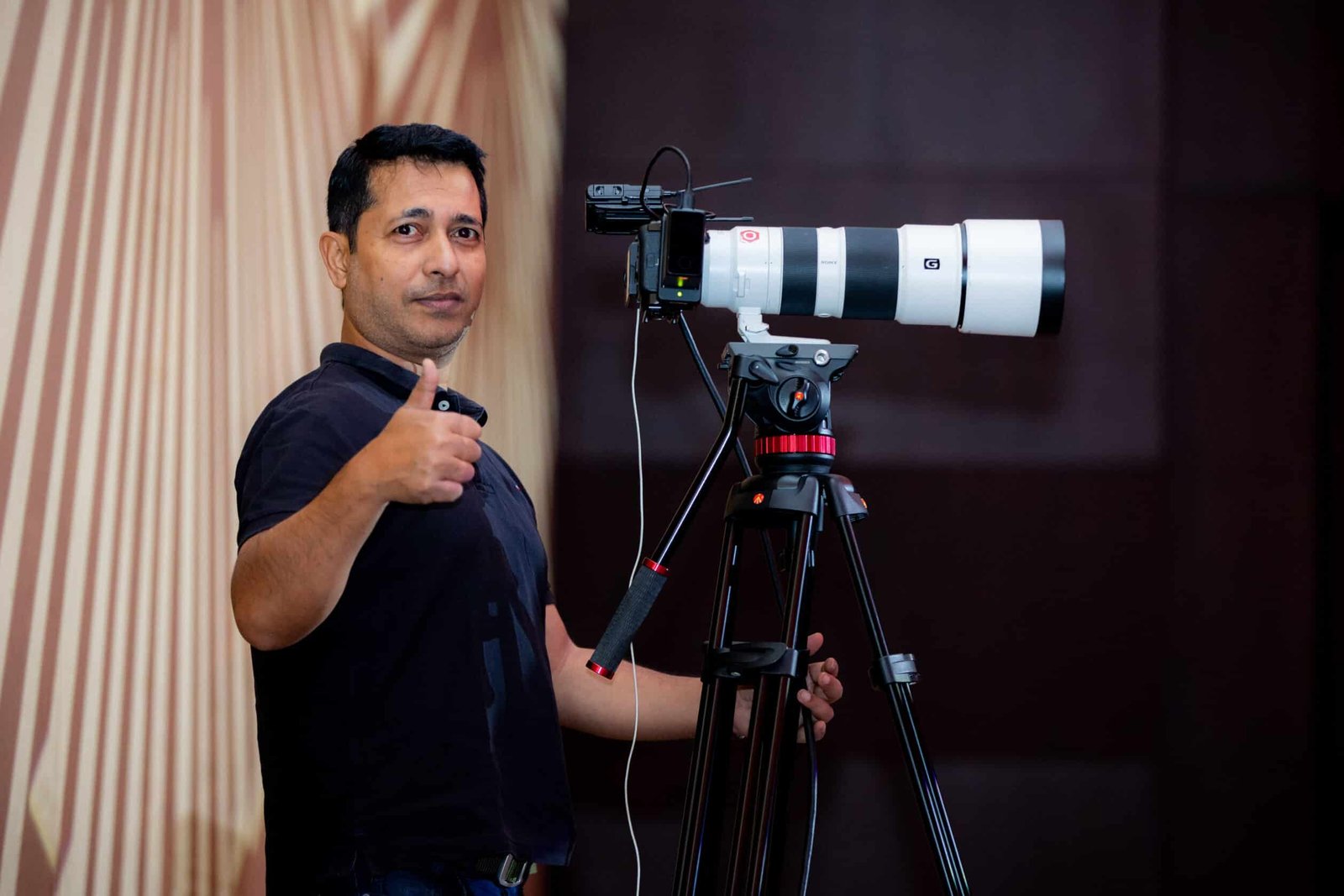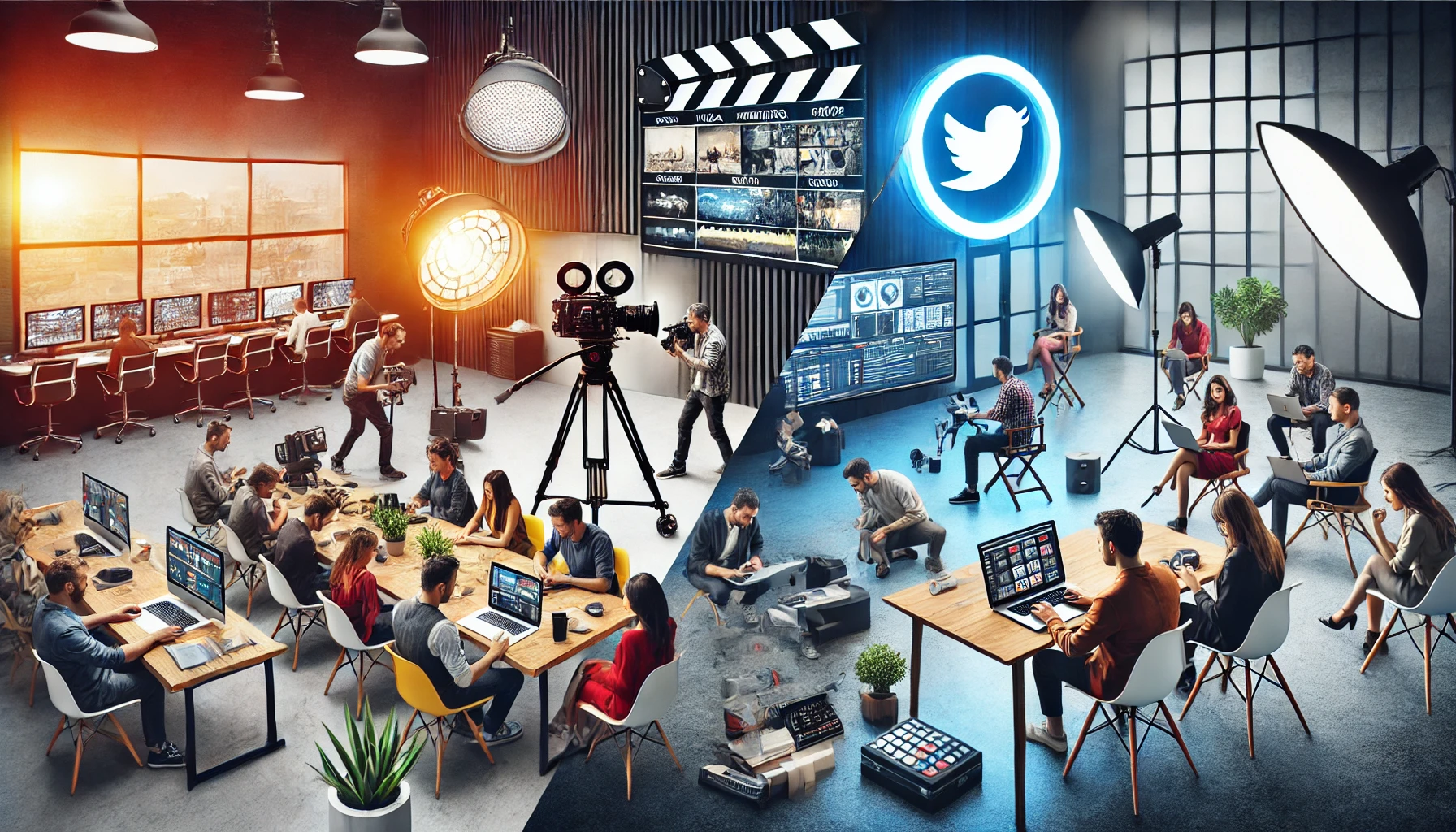Introduction to Video Editing
Video editing studio in Dubai deals with a fluid and creative procedure that entails altering video clips to efficiently convey a narrative or idea this is referred to as video editing. This complex procedure encompasses editing, trimming, transitions, and effects to enrich visual storytelling. Its significance in sectors such as entertainment, marketing, education, and journalism is paramount, as it engages viewers, delivers information succinctly, and elicits strong emotions.
Definition of Video Editing
The art of video editing involves manipulating and organising video footage to craft a seamless visual narrative. This encompasses tasks such as choosing, cutting, and arranging clips and incorporating transitions, effects, and audio components. Whether it’s removing unwanted segments or enhancing footage through colour grading and visual effects, the ultimate objective is to refine raw material into a polished final product that effectively communicates the desired message to the audience.
Importance of Video Editing in Various Industries
Video editing plays a crucial role across various industries by crafting compelling content that connects with viewers. It is indispensable in the entertainment sector for developing captivating movies, TV shows, and online content. A Video editing studio in Dubai is essential for producing promotional materials that successfully communicate brand messages. Moreover, it holds significance in education, journalism, and corporate communications for visually and effectively sharing information.
Evolution in Technologies of Video Editing Studios in Dubai

Video editing technologies have revolutionised the industry, making editing easier and more creative. Digital technology has replaced labour-intensive physical film editing with non-linear systems, allowing for the electronic manipulation of video files. Today, advanced software offers real-time editing, 3D effects, and collaborative workflows, pushing the boundaries of visual storytelling.
Fundamentals of Video Editing
The craft of video editing involves the skilful arrangement and manipulation of video footage to create a compelling and cohesive narrative. This passage could further elaborate on the significance of grasping the fundamentals of video editing, including the maintenance of continuity, pacing, and storytelling techniques.
Understanding Basic Terminology
To excel in video editing, it’s crucial to understand the fundamental terminology. This includes knowing different types of cuts, like straight, jump, and match cuts, and how they affect the video’s flow. Familiarity with transitions like fades, dissolves, and wipes is also important for seamless shot changes. Adding overlays such as text, graphics, and visual effects can enhance the video.
Introduction to Different Types of Editing Software
Video editing software provides tools to modify and manipulate video footage. Options like Adobe Premiere Pro, Final Cut Pro, and DaVinci Resolve offer unique features and interfaces. Familiarising oneself with different software helps choose the best one based on requirements, budget, and skill level.
Overview of Editing Workflow and Best Practices
Video editing is crucial for transforming raw footage into a visually appealing final product. It involves importing and organising files, selecting the best shots, determining the order and pacing, and adding visual effects and transitions. Enhancements such as adjusting colour, brightness, and audio quality are made before collaborating with the production team for high-quality results.
Choosing the Right Editing Software
Video editing studio in Dubai chooses the right software that is essential in order to accomplish your creative objectives and optimise productivity. With a wide range of choices available, it is crucial to comprehend the strengths and weaknesses of each platform. Specific editing requirements, skill level, and budget will play a significant role in determining your decision. By thoroughly assessing the features, compatibility, user interface, and overall workflow of various software options, one can pinpoint the one that aligns best with their needs and preferences.
Comparison of Popular Video Editing Software Options
To choose the right video editing software, carefully evaluate the available software. Each has unique strengths: Premiere Pro integrates well with Adobe Creative Cloud and offers extensive plugin support, Final Cut Pro is popular among Mac users for its seamless integration with Apple hardware and user-friendly interface, and DaVinci Resolve stands out for its advanced colour grading features and powerful editing tools.
Factors to Consider When Selecting Software
Various factors should be taken into account when choosing video editing software. To begin with, it is important to consider the features provided by each platform and how well they meet your editing needs. It is also crucial to ensure that the software is compatible with your computer hardware and operating system in order to achieve smooth performance.
Editing Techniques and Tips

Proficient video editing requires understanding various methods to develop captivating storylines, including cutting, trimming, and splitting. Advanced techniques like colour grading and special effects enhance visual and auditory components. Time-saving editing tricks and keyboard shortcuts improve workflow efficiency for professional outcomes.
Basic Editing Techniques
Video editing relies on fundamental editing techniques to enhance and organise footage. By cutting, editors can eliminate unnecessary segments, while trimming allows for adjusting clip duration to enhance the overall pacing. Splitting enables editors to divide clips into smaller segments, facilitating precise editing.
Advanced Editing Techniques
Advanced editing techniques surpass simple manipulation of footage, elevating the video by adding depth and refinement. Colour grading entails fine-tuning colours and tones to enhance the mood and maintain visual coherence. Audio mixing ensures balanced sound levels and incorporates effects to enhance clarity and immersion. Special effects, including transitions and visual overlays, heighten the production value and captivate viewers with mesmerising visuals.
Time-Saving Editing Tips and Keyboard Shortcuts
Efficiently edit content by utilising time-saving editing tips and keyboard shortcuts to streamline the process. Planning and staying organised will help editors work more systematically, saving time typically spent searching for assets and making quick decisions. Speed up editing tasks by using keyboard shortcuts for common actions, enabling editors to concentrate on creativity rather than manual tasks. Furthermore, templates and presets can be leveraged to expedite workflow and ensure consistency across projects.
Working with Different Types of Footage
When dealing with various types of footage, it is essential to comprehend the distinct characteristics and demands of each type. This includes raw footage captured by cameras, stock footage, and screen recordings. To ensure optimal quality during the editing process, one must possess knowledge about suitable codecs, colour profiles, and file formats. Additionally, handling different types of footage requires adapting editing techniques to meet the specific requirements of each type. This may involve tasks like adjusting colour grading, stabilising shaky footage, or synchronising audio and video.
Editing Tips for Different Types of Video Content
Different video genres, like interviews, action shots, music videos, documentaries, and commercials, require specific editing techniques. Interviews need seamless transitions and compelling storytelling. Action shots need to maintain energy and pace to capture the scene’s essence. Music videos often require creative visual effects and dynamic editing to sync with the music. Video editing studio in Dubai understands the goals and aesthetics of each genre and makes informed decisions about shot selection, pacing, audio syncing, and visual enhancements.
Handling Various File Formats and Resolutions
Video editors frequently come across a wide range of file formats and resolutions in their projects, spanning from standard definition to high definition and beyond. This entails accurately interpreting and converting the file formats to guarantee compatibility with the editing software. Dealing with different resolutions necessitates comprehending the aspect ratios, frame rates, and pixel densities in order to preserve the desired visual quality. By employing suitable scaling, cropping, and transcoding techniques when handling diverse file formats and resolutions, a smooth integration within the editing project can be ensured.
Incorporating Footage from Multiple Sources
Editors often work with footage from various recording devices, like cameras, smartphones, and drones. This means dealing with different file formats, colour profiles, and aspect ratios to create a cohesive visual presentation. To achieve this, editors must synchronise footage, maintain consistent colour grading and exposure, and ensure visual continuity. They can use tools like timecode syncing, colour matching, and image stabilisation to merge footage from different sources into a polished and captivating final product.
Adding Visual Enhancements
Enhancements to visuals enhance the quality and effectiveness of video content, increasing engagement and professionalism. These improvements include a range of elements like transitions, effects, text overlays, graphics, and animations, all of which work together to enrich the visual storytelling experience.
Incorporating Transitions and Effects
Enhancements to visuals enhance the quality and effectiveness of video content, increasing engagement and professionalism. These improvements include a range of elements like transitions, effects, text overlays, graphics, and animations, all of which work together to enrich the visual storytelling experience.
Using Text Overlays, Titles, and Lower Thirds
Text overlays, titles, and lower thirds play a vital role in offering context, conveying information, and directing viewers throughout the video content. They encompass titles that introduce different segments, captions for dialogue or narration, and lower thirds that showcase names or supplementary details about subjects.
Creating and Customising Graphics and Animations

Graphics and animations contribute to the depth and visual appeal of videos, resulting in a more dynamic and captivating experience. Video editing studio in Dubai incorporates visually appealing elements such as custom logos, animated intros, or motion graphics due to which the overall production value is elevated, capturing the audience’s attention effectively.
Enhancing Audio Quality
Improving the audio quality entails enhancing the sound attributes of an audio clip in order to attain a distinct and polished outcome. This can be achieved by utilising methods like equalisation, compression, and noise reduction to boost the frequency response, dynamics, and overall clarity of the audio.
Adjusting Audio Levels and Balancing the Sound
Balancing sound and adjusting audio levels are crucial for creating a seamless and captivating audio experience in a project. This involves fine-tuning the volume levels of each audio track, achieving a harmonious blend between dialogue, music, and sound effects, and maintaining consistent and suitable audio levels throughout the entire project.
Removing Background Noise and Enhancing Clarity
Background noise has the potential to disrupt the audio recording’s quality. It is essential to eliminate or minimise background noise to achieve a polished and professional audio output. This can be accomplished through the utilisation of noise reduction tools, spectral editing, or audio restoration techniques. Improving clarity entails reducing unwanted artefacts, enhancing the comprehensibility of dialogue, and refining the overall definition and sharpness of the audio.
Adding Music, Sound Effects, and Voiceovers
The inclusion of music, sound effects, and voiceovers plays a crucial role in the audio post-production phase. This entails choosing suitable music tracks and sound effects and recording and integrating voiceovers to elevate the overall audio quality of the project. Scrupulous attention is paid to timing, synchronisation with visuals, and the attainment of the desired emotional impact by thoughtfully selecting and positioning these audio components.
Exporting and Sharing Your Project

The last stage of the video editing process is exporting and distributing your project, guaranteeing that your content effectively reaches its target audience. This entails comprehending diverse export configurations and formats, enhancing video quality and file sizes, and disseminating the completed project across multiple platforms.
Understanding Different Export Settings and Formats
Various platforms and devices necessitate distinct export settings and formats to guarantee the best playback and compatibility. Familiarising yourself with the different choices at your disposal, including resolution, frame rate, codec, and container format, empowers you to customise your export settings to align with the specifications of your desired distribution platform.
Tips for Exporting High-Quality Videos with Optimal File Sizes
Video editing studio in Dubai provides efficient distribution and streaming with a careful balance between video quality and file size. By employing compression techniques and adjusting bitrate settings, they maintain a high level of video quality while minimising the size of the file. Furthermore, selecting the appropriate codec and optimising settings for web or mobile viewing can further decrease file sizes without compromising the quality of the video.
Sharing Your Finished Project on Various Platforms
Troubleshooting Common Editing Challenges
Video editing can present various challenges; however, knowing to troubleshoot common issues is essential for a seamless editing experience. This includes resolving problems like audio and video synchronisation, playback delays, software crashes, and other technical difficulties that may occur while editing.
Addressing Common Issues
Synchronising audio and video is a crucial element of video editing. However, there are instances when discrepancies arise, leading to audio or video being out of sync. Playback lag, characterised by video stuttering or freezing during playback, can further impede the editing process. Moreover, unexpected software crashes or freezes may occur, posing a risk of work loss and causing frustration.
Finding Solutions to Technical Problems and Errors
To address these issues, various troubleshooting methods can be used. For audio-video synchronisation, manual adjustment or synchronisation tools in editing software can be employed. To reduce playback lag, optimising hardware, updating software, or adjusting playback settings can help. In case of software crashes, updating drivers, clearing cache files, or reinstalling the editing software may be required.
To address these issues, various troubleshooting methods can be used. For audio-video synchronisation, manual adjustment or synchronisation tools in editing software can be employed. To reduce playback lag, optimising hardware, updating software, or adjusting playback settings can help. In case of software crashes, updating drivers, clearing cache files, or reinstalling the editing software may be required.
Conclusion
Acquiring expertise in video editing is essential for success. With the right skills, tools, and resources, the top video editing studio in Dubai can deliver unparalleled excellence in visual storytelling and content creation, setting new industry standards.








